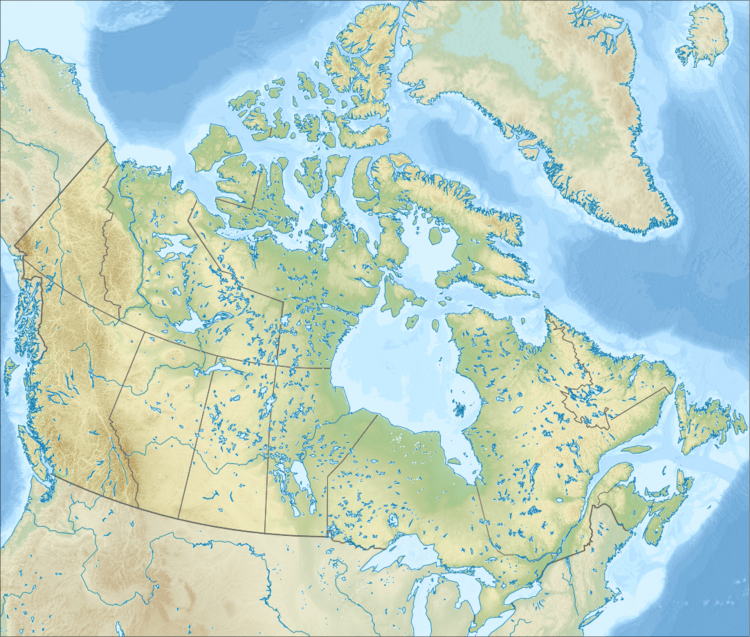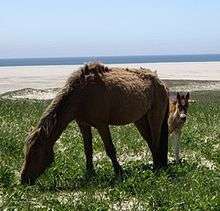Sable Island National Park Reserve
Sable Island National Park Reserve is a Canadian national park reserve comprising Sable Island, 300 km (190 mi) southeast of Halifax, Nova Scotia, and about 175 km (109 mi) southeast of the closest point of mainland Nova Scotia in the Atlantic Ocean.[1] Notable for its feral horses, the Sable Island horse, the island is protected under the Canada National Parks Act, requiring permission from Parks Canada to visit. The establishment of the park reserve means that the island, and the surrounding area within 1 nautical mile (1.9 km; 1.2 mi), cannot be drilled for oil or natural gas.[1] Sable Island became a National Park Reserve in June 2013,[2] with the intention of becoming a national park once Indigenous Canadian (Miꞌkmaq) land claims are settled.
| Sable Island National Park Reserve | |
|---|---|
IUCN category II (national park) | |
 | |
| Location | Halifax, Nova Scotia Nova Scotia Canada |
| Nearest city | Halifax, Nova Scotia |
| Coordinates | 43°57′00″N 59°54′57″W |
| Area | 30 km2 (12 sq mi) |
| Established | June 20, 2013 |
| Governing body | Parks Canada |
Ecology

Sable Island derived its name from the French word for "sand". It lacks natural trees, being covered instead with marram grass and other low-growing vegetation. In 1901, the federal government planted over 80,000 trees in an attempt to stabilize the soil; all died. Subsequent plantings resulted in the survival of a single Scots pine. Although planted in the 1960s, it is only a few feet tall.[3]
The island is home to over 550 free-roaming Sable Island horses,[4] protected by law from human interference. This feral horse population is likely descended from horses confiscated from Acadians during the Great Expulsion and left on the island by Thomas Hancock, Boston merchant and uncle of John Hancock.[5] In the past, excess horses were rounded up, shipped off the island, and sold, many used in coal mines on Cape Breton Island, Nova Scotia. In 1960, the Canadian Government, under the Canada Shipping Act, gave the horse population full protection from human interference.[4]
Harbour and grey seals breed on the island's shores. Seal counts from the 1960s for the grey seal population estimated 200–300 pups born at that time on the island, but surveys from as recent as 2003–2004 estimated the number of pups born in that season at 50,000.[6] The seals are occasionally predated by the various shark species that inhabit the waters nearby. Unusual 'corkscrew' bite wounds on dead seals suggest that the Greenland shark is probably responsible for most attacks here.[7] Several large bird colonies are resident, including the Arctic tern and Ipswich sparrow, a subspecies of the Savannah sparrow which breeds only on the Island. Many other species are resident, migratory, or transient, blown out to sea in storms and returned to land out of their natural range.
It was formerly believed the freshwater sponge Heteromeyenia macouni was found only in ponds on the island. However, it is now considered to be the same species as Racekiela ryderi, found elsewhere.[8]
Rabbits, cattle, and goats were also released on the island, with little success, at one point.[4]
At one point, there was a walrus population on the island, until hunters drove the population to extinction.[4]
See also
References
- "Sable Island named national park". CBC News. 2011-10-17. Retrieved 2011-10-17.
- "MP defends decision to vote for Sable Island national park". CBC News. 19 June 2013.
- "Green Horse Society - Fall Colours on Sable Island". Archived from the original on 2013-01-25. Retrieved 2012-08-22.
- National Geographic Guide to the National Parks of Canada, 2nd Edition. National Geographic Society. 2016. pp. 50–55. ISBN 978-1-4262-1756-2.
- "Free as the Wind: How the Horses Came to Sable Island", Sable Island: A story of Survival website Nova Scotia Museum
- Sable Island: Photographic Survey of Grey Seal Pups (Feb 2004) Archived 2012-09-05 at Archive.today
- Shark Predation on Sable Island Seals (July 2008) Archived 2012-12-09 at Archive.today
- van Soest, R. (2014). Van Soest RW, Boury-Esnault N, Hooper JN, Rützler K, de Voogd NJ, de Glasby BA, Hajdu E, Pisera AB, Manconi R, Schoenberg C, Janussen D, Tabachnick KR, Klautau M, Picton B, Kelly M, Vacelet J (eds.). "Heteromeyenia macouni MacKay, 1900". World Porifera database. World Register of Marine Species. Retrieved 2014-05-22.